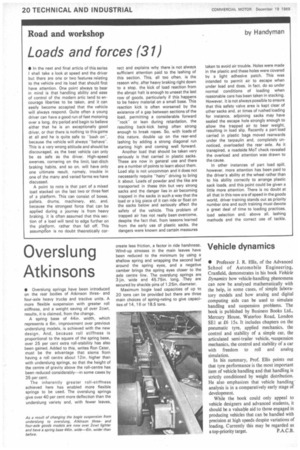Road and workshop
Page 22

If you've noticed an error in this article please click here to report it so we can fix it.
Loads and forces (31)
• In the next and final article of this series I shall take a look at speed and the driver but there are one or two features relating to the vehicle and its load that should first have attention. One point always to bear in mind is that handling ability and ease of control of the modern artic tend to encourage liberties to be taken, and it can easily become accepted that the vehicle will always respond. Quite often a young driver can have a good run of fast motoring over a long, dry period and begin to believe either that he is an exceptionally good driver, or that there is nothing to this game at all and he is quite safe to "bash on", because the vehicle will always "behave-. This is a very wrong attitude and should be discouraged, as the best vehicle can only be as safe as the driver. High-speed swerves, cornering on the limit, last-ditch braking habits, and so on. will have only one ultimate result, namely, trouble in one of the many and varied forms we have discussed.
A point to note is that part of a mixed load stacked on the last two or three feet of a platform. This can consist of boxes, pallets, drums, machinery, etc, and, because the strongest force that can be applied during a journey is from heavy braking, it is often assumed that this section of a load will tend to edge further on the platform, rather than fall off. This assumption is no doubt theoretically cor
met and explains why there is not always sufficient attention paid to the lashing of this section. This, all too often, is the reason why, after heavy braking right down to a stop, the kick of load reaction from the abrupt halt is enough to unseat the last row of goods, particularly if this happens to be heavy material on a small base. This reaction kick is often worsened by the existence of a gap between sections of the load, permitting a considerable forward "rockor lean during retardation, the resulting back-kick being often strong enough to break ropes. So, with loads of this nature, double up on the rear-end lashing by adding a strong diagonal run starting high and coming well forward.
Another load that should be taken very seriously is that carried in plastic sacks. These are now in general use and there are a number of points to learn about them. Load slip is not uncommon and it does not necessarily require "hairydriving to bring it about. Loads of powder and the like are transported in these thin but very strong sacks and the danger lies in air becoming trapped in the sacks in such a way that the load or a big piece of it can ride or float on the sacks below and seriously affect the safety of the vehicle. This problem of trapped air has not really been overcome, despite the fact that, from lessons learned from the early use of plastic sacks, the dangers were known and certain measures
taken to avoid air trouble. Holes were made in the plastic and these holes were covered by a light adhesive patch. This was intended to permit air to escape when under load and does, in fact, do so under normal conditions of loading when reasonable care has been taken in stacking. However, it is not always possible to ensure that this safety valve area is kept clear of other sacks and, at times of rushed loading for instance, adjoining sacks may have sealed the escape hole strongly enough to allow the trapped air to bear weight, resulting in load slip. Recently a part load carried in plastic bags moved rearwards under the tarpaulin and, completely unnoticed, overloaded the rear axle. As it transpired. a roadside MoT check revealed the overload and attention was drawn to the cause.
In other instances of part load spill, however, more attention has been paid to the driver's ability at the wheel rather than to his ability correctly to arrange plastic sack loads, and this point could be given a little more attention. There is no doubt at all that in this new era of speed in the goods world, driver training stands out as priority number one and such training must devote a great deal of time to loading practices, load selection and, above all, lashing methods and the correct use of tackle.












































































